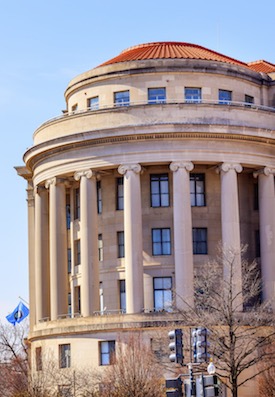 In the near future, the Federal Trade Commission is going to release the results of its study on patent assertion entities (PAEs)[1]. While it is very clear that we need additional information to understand the many complex business models that exist in the patent licensing world, the FTC’s study is unlikely to produce that information because of a few very critical flaws. What follows is an executive summary of my article, Sticks and Stones: How the FTC’s Name-Calling Misses the Complexity of Licensing-Based Business Models, published in the George Mason Law Review.
In the near future, the Federal Trade Commission is going to release the results of its study on patent assertion entities (PAEs)[1]. While it is very clear that we need additional information to understand the many complex business models that exist in the patent licensing world, the FTC’s study is unlikely to produce that information because of a few very critical flaws. What follows is an executive summary of my article, Sticks and Stones: How the FTC’s Name-Calling Misses the Complexity of Licensing-Based Business Models, published in the George Mason Law Review.
The premise of the FTC’s study is good. Most data on PAE activity is limited to publicly available information (i.e., litigation data), ignoring that the bulk of patent licensing behavior takes place before, and therefore outside, litigation. Using its 6(b) power, the FTC can obtain non-public data, including information about licensing requests, negotiations, patent acquisitions, and other activities that PAEs engage in. As the FTC noted, the study “will add significantly to the existing literature and evidence about PAE form, structure, organization, and behavior.” This information would be invaluable to those who study PAEs as well as to policy makers who remain concerned about PAE activity.
Specifically, the data that could be obtained through the FTC’s 6(b) study could do much to expose how much of the “patent troll” rhetoric is based in reality and how much is based on fear of what we do not know or understand. After all, it is always what is hidden that is the scariest. Although licensing of patent rights has occurred for hundreds of years, we simply do not understand its effects on innovation and the economy – in part because we do not understand patent licensing activity in general. While the FTC could have conducted a study that resulted in a “detailed understanding of the complex world of patent licensing firms,” the FTC’s study is instead “slanted in such a way that only part of the story will be uncovered. Worse still, the study has been shaped in a way that will simply add fuel to the anti-“patent troll” fire without providing any data that would explain the best way to fix the real problems in the patent field today.”
I describe two specific problems with the FTC’s study: one is definitional, the second is methodological.
First, the definition of PAE used by the FTC characterizes all PAEs as the same. But in treating patent licensing firms as a homogenous category, the FTC fails to recognize there is a wide spectrum of business models that exist under the licensing umbrella. It is “naïve and inaccurate” to lump them all together. The FTC’s study is explicitly “premised on a one-size-fits-all conception of patent licensing firms.” Where a well-designed study could shine an important light on the complex innovation ecosystem, the FTC instead squanders this opportunity from the outset by failing to recognize that not all PAEs are the same.
Second, and related to the first, there are serious methodological questions that undermine any conclusions that could be drawn from the FTC’s data. And, in all honesty, although the study should simply “present[ ] descriptive data and descriptive analytics” to the world, the reality is that the data will be used in the war on PAEs. For that reason, it is even more troubling that the study is badly designed. Bad data being used to justify bad policy is the worst of all results.
The problem is that the FTC’s study is not asking the right questions. In order to understand the complex business models that compose the PAE ecosystem, we cannot simply count the number of patents a firm has or tabulating license negotiations. Rather, to understand PAEs, the FTC should be asking why patentees sell their patents to licensing firm or why licensing firms buy from patentees. An important question that is completely overlooked? Why did the PAE decide to become a patent licensing firm in the first place? Because that matters. It is not enough to ask PAEs what they do – we need to also understand why. And based on my prior research, these reasons vary greatly. Some begin as patent licensing firms. “Others invent new technology but are unable to successfully commercialize it, despite making efforts to do so. Still others exist as practicing entities for years or decades before something changes – supply change issues, rampant infringement by competitors, and regulatory initiatives – and they are no longer able to exist as a viable practicing entity.” The FTC’s questions are not designed to showcase the differences between these firms.
Although the FTC claims it wants to understand how PAEs affect innovation and competition, they are starting from the wrong place and only moving backwards from there. The first step to understand about the patent licensing ecosystem is that the members are different. By structuring its study based on this fundamental misunderstanding and by not seeking any information that could help illuminate this point, the FTC’s study will undoubtedly produce results that lack nuance and are inaccurate. The old computer adage holds here – garbage in, garbage out. And while that truth is problematic in the programming world, the potential effects here – where policy makers will rely blindly on the FTC’s results – are far too important to base on garbage.
_______________
[1] Although I prefer the term “patent licensing firm” to PAE (or NPE or patent troll), I defer to the FTC’s choice of moniker.

![[IPWatchdog Logo]](https://ipwatchdog.com/wp-content/themes/IPWatchdog%20-%202023/assets/images/temp/logo-small@2x.png)

![[Advertisement]](https://ipwatchdog.com/wp-content/uploads/2024/04/Patent-Litigation-Masters-2024-sidebar-early-bird-ends-Apr-21-last-chance-700x500-1.jpg)

![[Advertisement]](https://ipwatchdog.com/wp-content/uploads/2021/12/WEBINAR-336-x-280-px.png)
![[Advertisement]](https://ipwatchdog.com/wp-content/uploads/2021/12/2021-Patent-Practice-on-Demand-recorded-Feb-2021-336-x-280.jpg)
![[Advertisement]](https://ipwatchdog.com/wp-content/uploads/2021/12/Ad-4-The-Invent-Patent-System™.png)







Join the Discussion
6 comments so far.
Paul F. Morgan
April 21, 2016 01:35 pmSend a copy of your article directly to the FTC staff running this study. That is more likely to be read by FTC staff than a law school publication or an IPL blog.
EG
April 21, 2016 07:29 amHey Kristen,
What Anon is alluding to is the fact that the FTC is not alone in having this problem. Much of U.S. governmental policy (that includes Congress) in the patent area is based upon studies which are asserted as being factually based, but are extremely flawed in terms the methodology used to generate those facts. These studies are driven by agendas that are virulent anti-patent. Jim Bessen & Co. up at Boston University are notorious for this problem.
staff
April 21, 2016 12:55 am‘the results of its study on patent assertion entities’
Whatever their ‘business model’ is it doesn’t matter. All that matters is whoever owns the patent owns the invention, including the right to license or exclude all who would use it. It’s a property right, for Pete’s sake. Will the insanity please STOP! Stop listening to the Chinese style propaganda of legalized invention theft. Can anyone reason anymore?
For our position and the changes we advocate to truly reform the patent system, or to join our effort, please visit us at https://aminventorsforjustice.wordpress.com/category/our-position/
or, contact us at [email protected]
Anon
April 20, 2016 03:30 pmPost caught in filter, please release and delete this notice – thanks
Anon
April 20, 2016 03:26 pmI am reminded that Ron Katznelson’s request to the executive branch seeking clarity (and correction) of the “Tr011” narrative is now over a year old.
Does, or perhaps, will, this FTC report need some “corrections” in the same vein?
And would the desire for accuracy be in vain?
Edward Heller
April 20, 2016 12:01 pmIf an inventor could not sue infringers because his startup failed, then I would suggest that we would have fewer inventors and fewer startups.